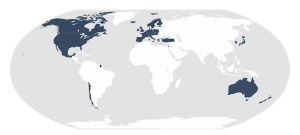In the last year or so immigration has been in the news extensively. Political and religious refugees, economic refugees, and illegal immigration. It is a problem we have faced in the United States, Europe is dealing with it, and there is a mass of conflicting and unclear data.
Immigration Policies in Comparison (IMPIC)
The Immigration Policies in Comparison aims to give us clearer data sets. It focuses on the Organization for Economic Co-operation and Development (OECD) countries. Which consists of 35 member countries that span the globe, and 5 of 7 continents. They were granted funding for the project by the Emmy-Noether Program of the German Research Foundation from 2011-2016. The IMPIC project provides sophisticated quantitative indices as a measure of policy, with a focus on the 30 year period of 1980-2010. The goal being a new data set that allows the systemic study of the causes and effects of immigration policies.

Highlights a map of the 35 nations that is part of the OECD. It does not include those cooperatives with non-member countries.
The team that developed this ground-breaking quantitative index was headed by Marc Helbling, a professor of political sociology at the University of Bamberg, and a senior researcher at the WZB Berlin Social Science Center. He was joined by 5 research collaborators, and seven student collaborators.
How IMPIC is Structured
The IMPIC defines “immigration policies” as those government statements of actionable intention; regarding the selection, admission, settlement and deportation of foreign citizens residing within the country. Also the data set is limited to legal regulation, and therefore excludes implementation data. The four policy fields that data set covers includes:
- Labor Migration or Economic Reasons
- Family Reunification or Social Resons
- Asylum/Refugees or Humanitarian Reasons
- Co-ethnics or Cultural Reasons
Data is provided in two dimensions of states’ regulation; constrained immigration rights as well as the mechanisms that monitor compliance with regulations. The second dimension is that of internal and external regulations and controls. The data set further deaggregates internal and external regulations into four sub-dimensions:
- Eligibility Requirements (Follows MIPEX data set distinguishers)
- Conditions
- Security of Status
- Rights
All of this data is useful to researchers and policy makers. It will allow them to intelligently answer questions such as:
- Which are the most restrictive and most liberal countries?
- Have policies become more liberal or restrictive over time?
- Are there groups of countries whose policies present similar patterns?
- What factors lead to more restrictive and, conversely, more liberal policies?
- Do restrictive policies indeed lead to lower immigration rates?
- How great is the impact of immigration policies on immigration rates compared to other factors?
Results of IMPIC Study
“We also find that immigration policies have an important effect on immigration rates” (Helbling and Leblang, 2017).
The first round of analysis has shown that conditions and criteria for entering and remaining in the country has become easier. This is especially for the following groups; labor migrants, asylum seekers, and those seeking family reunification. More restrictive controls have been put on the adherence monitoring to policies. There are several factors that contribute to immigration beyond these; restrictive immigration policy effects increase when there is higher unemployment, whether or not the migrants are from colonies or there is an established ethic community in the destination country, however the Europeanization effect is only partially applicable due to the common trends in migration policy with variable policy field intensity between EU and non-EU countries.



Leave a Reply